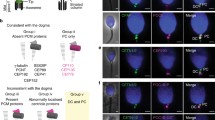Abstract
The prevailing assumption has been that the human spermatozoon provides only one centriole to the zygote: the proximal centriole, with a canonical, cylinder-like shape. This overly simplistic view has come under challenge since discovering that the human spermatozoon provides a second, atypical centriole to the zygote. The study of human zygotes is challenging for ethical reasons, and bovine zygotes provide an important model due to a similarity in centrosome embryonic inherence and function. Detailed ultrastructural analyses by Uzbekov and colleagues identify the persistence of atypical centrioles in bovine early embryos, raising questions about the original single-centriole model. Whether the parental origin of nascent atypical centrioles or their wide structural diversity and deviation from the canonical centriolar form in blastomeres constitutes sufficient evidence to warrant a reconsideration of the single-centriole model is discussed herein. Because previous human studies identified only one canonical centriole in the zygote, atypical centrioles are likely present in the early human embryo; therefore, it is time to rethink the role of paternal centrioles in human development.

Similar content being viewed by others
References
Manandhar G, Simerly C, Schatten G. Highly degenerated distal centrioles in rhesus and human spermatozoa. Hum Reprod. 2000;15(2):256–63.
Crozet N. Behavior of the sperm centriole during sheep oocyte fertilization. Eur J Cell Biol. 1990;53(2):326–32.
Avidor-Reiss T. Rapid evolution of sperm produces diverse centriole structures that reveal the most rudimentary structure needed for function. Cells. 2018;7(7):67.
Fishman EL, et al. A novel atypical sperm centriole is functional during human fertilization. Nat Commun. 2018;9(1):2210.
Uzbekov R, et al. Centrosome formation in the bovine early embryo. Cells. 2023;12(9):1335.
Schatten H, et al. Behavior of centrosomes during fertilization and cell division in mouse oocytes and in sea urchin eggs. Proc Natl Acad Sci U S A. 1986;83(1):105–9.
Leung MR, et al. The multi-scale architecture of mammalian sperm flagella and implications for ciliary motility. EMBO J. 2021;40(7):e107410.
Khanal S, et al. A dynamic basal complex modulates mammalian sperm movement. Nat Commun. 2021;12(1):3808.
Amargant F, et al. The human sperm basal body is a complex centrosome important for embryo preimplantation development. Mol Hum Reprod. 2021;27(11);gaab062.
Nakamura S, et al. Human sperm aster formation and pronuclear decondensation in bovine eggs following intracytoplasmic sperm injection using a Piezo-driven pipette: a novel assay for human sperm centrosomal function. Biol Reprod. 2001;65(5):1359–63.
Simerly C, et al. The paternal inheritance of the centrosome, the cell's microtubule-organizing center, in humans, and the implications for infertility. Nat Med. 1995;1(1):47–52.
Cavazza T, et al. Parental genome unification is highly error-prone in mammalian embryos. Cell. 2021;184(11):2860–2877 e22.
Schneider I, et al. Dual spindles assemble in bovine zygotes despite the presence of paternal centrosomes. J Cell Biol. 2021;220(11):e202010106.
Loppin B, Dubruille R, Horard B. The intimate genetics of Drosophila fertilization. Open Biol. 2015;5(8):150076.
Kawamura N. Fertilization and the first cleavage mitosis in insects. Dev Growth Differ. 2001;43(4):343–9.
Sathananthan AH, et al. The sperm centriole: its inheritance, replication and perpetuation in early human embryos. Hum Reprod. 1996;11(2):345–56.
Sathananthan AH, et al. Centrioles in the beginning of human development. Proc Natl Acad Sci U S A. 1991;88(11):4806–10.
Reese ST, et al. Pregnancy loss in beef cattle: a meta-analysis. Anim Reprod Sci. 2020;212:106251.
Quenby S, et al. Miscarriage matters: the epidemiological, physical, psychological, and economic costs of early pregnancy loss. Lancet. 2021;397(10285):1658–67.
Macklon NS, Geraedts JP, Fauser BC. Conception to ongoing pregnancy: the 'black box' of early pregnancy loss. Hum Reprod Update. 2002;8(4):333–43.
ACOG. ACOG Practice bulletin No. 200: Early pregnancy loss. Obstet Gynecol. 2018;132(5):e197–e207.
Koyama H, et al. Analysis of polarity of bovine and rabbit embryos by scanning electron microscopy. Biol Reprod. 1994;50(1):163–70.
Bangs FK, et al. Lineage specificity of primary cilia in the mouse embryo. Nat Cell Biol. 2015;17(2):113–22.
Acknowledgements
We thank Derek Kluczynski, Katerina Turner, Luke A. Achinger, Nahshon Puente, and David Albertini for editing and commenting on the manuscript.
Funding
This project was supported by Agriculture and Food Research Initiative Competitive Grant number OHOW-2020-02790 from the USDA National Institute of Food and Agriculture and Grant number 1R15HD110863 from NIH-NICHD.
Author information
Authors and Affiliations
Corresponding author
Ethics declarations
Competing interests
The authors declare no competing interests.
Additional information
Publisher’s Note
Springer Nature remains neutral with regard to jurisdictional claims in published maps and institutional affiliations.
Highlights
• Most early embryonic centrioles are structurally atypical.
• The atypical spermatozoan distal centriole remains atypical in the embryo while “duplicating” new centrioles.
• The canonical spermatozoan proximal centriole changes in the embryo, sometimes acquiring an atypical structure.
• The first two new centrioles formed in the zygote are structurally atypical.
Rights and permissions
Springer Nature or its licensor (e.g. a society or other partner) holds exclusive rights to this article under a publishing agreement with the author(s) or other rightsholder(s); author self-archiving of the accepted manuscript version of this article is solely governed by the terms of such publishing agreement and applicable law.
About this article
Cite this article
Avidor-Reiss, T., Uzbekov, R. Revisiting the mystery of centrioles at the beginning of mammalian embryogenesis. J Assist Reprod Genet 40, 2539–2543 (2023). https://doi.org/10.1007/s10815-023-02927-4
Received:
Accepted:
Published:
Issue Date:
DOI: https://doi.org/10.1007/s10815-023-02927-4




